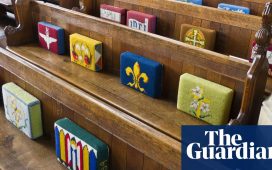Surrounded by a brutalist modern-day industrial estate, an extraordinary piece of 19th-century architecture peeps out from behind an overgrown hedge.
The Grade II*-listed building described by English Heritage as “one of the highlights of Victorian Gothic architecture in the country” is the oldest surviving synagogue in Manchester. However, this red-brick mismatch with its surroundings is somewhat unloved, after being deserted by its congregation in the 1980s.
The Victorian building, Moorish in style and built by Jewish cotton traders from Spain and Portugal, sits in what was once a thriving Jewish quarter. Its congregation were Sephardi Jews, originally from the Iberian peninsula.

In 1911 more than 30,000 Jewish people lived and worked in Cheetham Hill, one of Manchester’s most culturally diverse suburbs, which has also been home to Irish, Caribbean and Asian immigrants. But the community left for the leafier suburbs to the north and south of the city and the area’s synagogues were abandoned, demolished or converted.
Now sitting among takeaways and wholesale textile warehouses, and just a few streets away from Strangeways prison, this synagogue’s survival is exceptional.
Given a new lease of life as the Manchester Jewish Museum in 1984 – Britain’s only Jewish museum outside London – it became home to more than 30,000 objects, from personal letters and photographs to Torah scrolls hidden from the Nazis during WWII. These objects tell the story of Jewish Manchester as well as broader stories of migration, identity and the Holocaust.
But all agree that it is due a facelift. It was last refurbished more than three decades ago and its size means that curators have only ever been able to showcase about 1% of the collection.

In just a few days the museum will close its doors for almost two years for an ambitious £5m development project, partly funded by a national lottery grant of £2.89m in 2017.
There will be a new cafe serving hot salt beef bagels, chicken soup with matzo balls and potato latkes. The museum itself will double in size, with new galleries, learning spaces and a shop built in an extension connected to the existing building by a glass bridge.
But for its chief executive, Max Dunbar, who has worked at the National Portrait Gallery, Christie’s auctioneers and the World Rugby Museum, the most exciting part of the project is the new “learning kitchen”.
In recent years the former synagogue has become an event space for the local community, hosting everything from Bollywood concerts to hip-hop nights and Polish dumpling tastings.

Dunbar said: “We have always found that food brings people together, so the learning kitchen will be a community space where we will break bread together, have curry nights and allow people to interact in a way that they wouldn’t normally.
“We are very conscious that we need to support this community and reach out to them. This will not just be a space for the Jewish people here, it will be for everyone. We are planning to challenge the perception of what a Jewish museum is.”
The redeveloped museum is hoping annual visitor numbers will rise from 10,000 to 40,000 when it opens in 2021.
As the museum packs up to move to its temporary home in Manchester Central Library, its creative producer, Laura Seddon, says she has made some “exciting discoveries” – this being the first time in years all of the museum’s collections have been opened and catalogued.
Seddon discovers a second world war letter from a Jewish family, the Leisers, thanking the Singleton family in Moss Side for the care of the Leisers’ children Fanny and Manfred, who had come from Germany on the kindertransport. Fanny and Manfred travelled to the US in 1947 aged 16 and 13 and were reunited with their mother.
The letter ends: “I thank you a thousand times for what you have done for my children and me.”
Dunbar hopes that stories like this will help bring communities together in what he described as “troubled times”.
“The stories we are uncovering of Manchester’s Jewish community are also the stories of today. We learn about Jewish people who were forced to flee their homes and settled in alien environments trying somehow to rebuild their shattered lives.
“These stories remind us what happens when politics and religion seek to drive us apart and how a wonderful, diverse city like Manchester can bring people together.”






